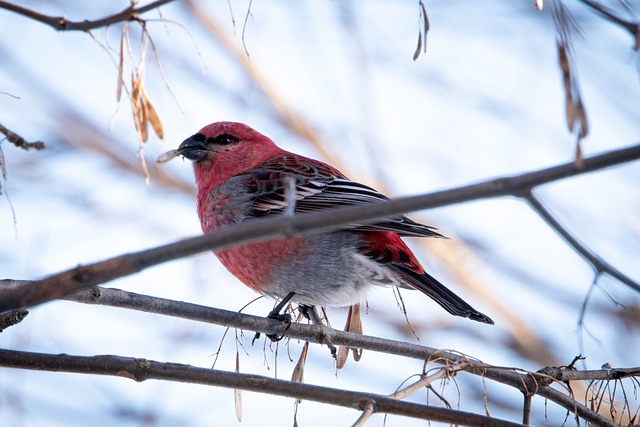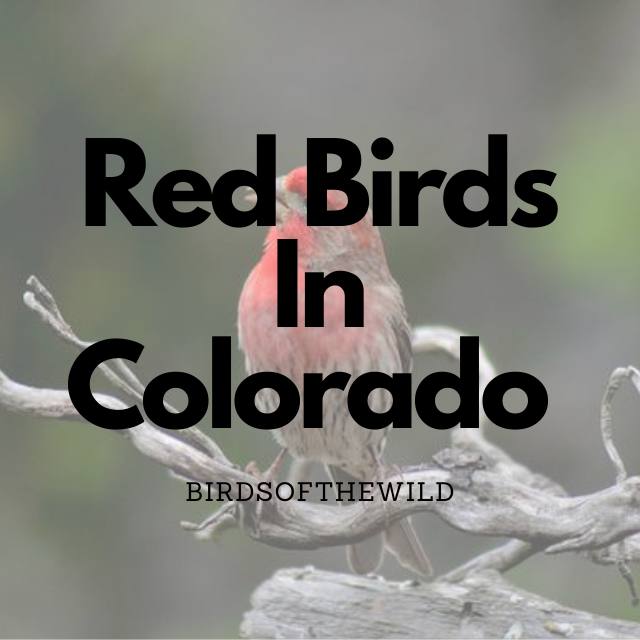You can find a variety of red birds staying within the state of Colorado so, if you’ve found yourself on here, I’ll be going over 7 unique red birds that consider the state as their home and should be possible to spot if you find yourself near their general habitats.
- House Finch
- Northern Cardinal
- Red Headed Woodpecker
- Northern Flicker
- Rose Breasted Grosbeak
- Pine Grosbeak
- White Winged Crossbill
7 Red Birds In Colorado
1. House Finch (Haemorhous Mexicanus)

- Size: 12.5 – 15cm
- Weight: 19 – 22 grams
- Wingspan: 20 – 25cm
House finches can be found in Colorado all throughout the year as it’s where they stay on a permanent basis.
A House finch can be recognised by its red and brown plumage with their body mostly light brown and the head made up of a gradient red color with hints of brown. Females on the other hand are mostly brown with hints of black on their wings and back.
As for where you can find house finches, the number of habitats they stay within are quite vast ranging from dry desert, desert grassland, chaparral, oak savannah, streamsides, and open coniferous forests at elevations below 6,000 feet.
If the food is to their liking, like black sunflower seeds, these little birds will on occasion make their way to a feeder set out by a citizen. Other than seeds house finches also eat small insects like aphids as well as fruits and berries.
In the wild, house finches are known to live for around 10 years whilst captive finches can live upwards of 12 years.
2. Northern Cardinal (Cardinalis Cardinalis)

- Size: 21 – 23cm
- Weight: 42 – 48 grams
- Wingspan: 30 – 35cm
You’ll be able to find northern cardinals in the eastern border of Colorado on a year round basis.
Northern cardinals are recognised by their mohawk-like head feathers, red exterior and beak with elements of black across the face. Females also have elements of red on their beaks and their body but, in smaller amounts, with the majority of their plumage a light brown color.
These cardinals can be found in woodlands, gardens, shrublands, wetlands and backyards if the sugar water or seeds in the feeders satisfy their taste buds.
As for the food they eat, it consists of small insects like beetles, true bugs, grasshoppers, caterpillars, ants, flies, spiders, centipedes, and snails. Seeds of weeds, berries among other smaller fruits are part of their diet too.
Northern cardinals are known to live for around 15 years in the wild although the actual number probably a lot less.
3. Red Headed Woodpecker (Melanerpes Erythrocephalus)

- Size: 19 – 25cm
- Weight: 56 – 97 grams
- Wingspan: 40 – 45cm
These red headed woodpeckers can be found in central and eastern Colorado throughout breeding season. This is typically around the spring and summer months.
Red headed woodpeckers are recognised by their red head and their black and white body and wings.
These woodpeckers tend to spend the majority of their time in groves, farm country, orchards, shade trees in towns, large scattered trees where you can find them in forest edges, orchards, open pine woods and the groves of taller trees.
A red headed woodpeckers diet consists of a wide variety of insects which includes spiders, earthworms, different types of nuts, seeds, berries along with other fruits. Sometimes these peckers may even eat small rodents or the contents of another birds eggs.
As for their lifespan, red headed woodpeckers have been known to live up to 10 years in the wild.
4. Northern Flicker (Colaptes Auratus)

- Size: 30 – 35cm
- Weight: 115 – 125 grams
- Wingspan: 50 – 55cm
You’ll be able to spot northern flickers scattered all across Colorado on a year round basis.
Northern flickers are recognised by their mostly cream colored body with black spots, orange and black tail feathers and elements of red on the lower part of their face. Females look very similar to the males minus the red elements on their face.
You’ll often find northern flickers around woodlands, forest edges, and open fields with scattered trees, as well as city parks and suburbs.
As for what they tend to eat, it includes mostly insects along with smaller fruits and berries.
Northern flickers are known to live for around 5 – 7 years on average with the longest recorded to be 9 years and 2 months.
5. Rose Breasted Grosbeak (Pheucticus Ludovicianus)

- Size: 18 – 22cm
- Weight: 35 – 65 grams
- Wingspan: 29 – 33cm
You’ll typically find rose breatsed grosbeaks making their migratory passage through the central and eastern regions of Colorado. This will generally occur when migrating towards their breeding residence and when travelling to where they’ll be wintering.
Rose breasted grosbeaks are recognised by their black, white and red plumage where their back is black, their wings and wing tail feathers a mixture of black and white with their breast white, with a triangular red shape closer to the neck. Females on the other hand are mostly brown and white.
As for where you can find these grosbeaks, it will often be around deciduous forest, woodlands, parks and gardens.
Rose breasted grosbeaks are known to consume a variety of different food sources such as seeds like sunflower seeds or safflower, small insects as well as berries and other smaller fruits.
These rose breasted grosbeaks are known to live for around 7 years in the wild and significantly longer in captivity, extending to about 24 years there.
6. Pine Grosbeak (Pinicola Enucleator)

- Size: 20 – 25.5cm
- Weight: 52 – 58 grams
- Wingspan: 31 – 35cm
You’ll be able to find pine grosbeaks in most of Colorado when they aren’t breeding but, around the western border and south eastern areas of the state they can be spotted year round.
Pine grosbeaks are recognised by their greyish white wings and tail feathers, a redish pink body and head along with a black beak and feet. Female grosbeaks are not nearly as vibrant as the males with their plumage a generally light gray color with hints of orange around the torso and tail.
Pine grosbeaks spend the majority of their time within coniferous woods where the may straddle on a horizontal branch when resting and hunt for small insects, seeds, buds, berries among other refreshing fruits when on the move.
These birds are known to live up till 9 years old, sometimes even more so they have a moderately long lifespans for birds of their size.
7. White Winged Crossbill (Loxia Leucoptera)

- Size: 15 – 17cm
- Weight: 24 – 30 grams
- Wingspan: 26 – 28cm
White winged crossbills are mostly non breeding residents within Colorado but there are small regions on the eastern part of the state where they are year round residents.
These white winged crossbill (also called two barred crossbills) are recognised by their red plumage across the head and body, black wings with white stripes and their downward pointing bill that crosses over itself. On the other hand females are mostly gray and green in color.
These crossbills can be found living in montane coniferous forests among boreal trees with mature spruce and larch. As for what the two barred crossbill eat, it includes pine cones, grass, docks, thrift seeds as well as smaller insects like caterpillars, aphids, spiders etc.
White winged crossbills are also known to live for around 4 years in the wild although the numbers may differ for captive ones.
Amhil Khan, a dedicated nature enthusiast and the founder of BirdsOfTheWild.com, is a passionate advocate for the captivating world of avian wonders. With a deep-seated curiosity about the intricate lives of birds, Amhil’s journey began as a fascination and has evolved into a mission to inspire others to appreciate and protect these magnificent creatures.
Amhil’s love for birds led to the creation of Birds of the Wild, a platform where his expertise in ornithology, coupled with his captivating storytelling, provides readers with an immersive and educational experience. Through his lens and words, he captures the essence of birds in their natural habitats, offering a glimpse into their behaviors, migrations, and the ecosystems they inhabit.

